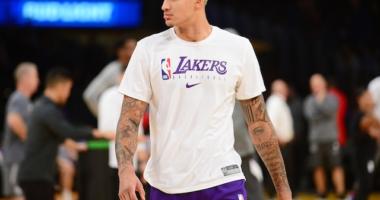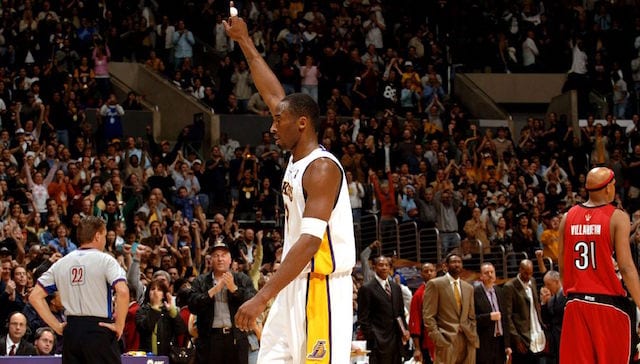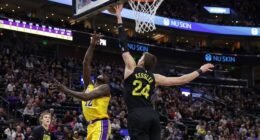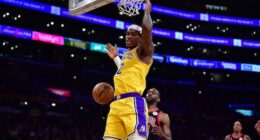Just over a year ago, the Los Angeles Lakers made a sneaky smart deal sending Steve Blake to Golden State for Kent Bazemore, a young player who had shown flashes of legitimate potential.
In 23 games with L.A., Bazemore averaged 13.1 points, 3.3 rebounds and 3.1 assists.
After the season, the Lakers declined to make a $1.1 million qualifying offer that would have turned Bazemore into a restricted free agent. The QO would have meant a $3 million cap hold and for their runs at LeBron James and Carmelo Anthony, the Lakers needed every ounce of available cap space to make their offers as lucrative financially as possible. As a result, Bazemore became an unrestricted free agent. While the Lakers showed interest in bringing him back (and Bazemore was amenable), they relinquished any extra influence over where he might end up.
Meanwhile, Bazemore, basically a league-minimum guy for the first two years of his career, wasn’t going to hang out while other options were put on then potentially removed from the table. While the Lakers waited for Melo, he signed a two-year, $4 million deal with Atlanta. Losing Bazemore, who won’t turn 26 until July and is playing meaningful minutes on the Eastern Conference’s best team, was part of the price paid to go big game hunting.
This summer, the role of Bazemore — i.e. the young player the Lakers would like to keep but will impact their ability to chase higher profile free agents — will be played by Ed Davis. How they handle his free agency will provide serious insight into the team’s overall approach to rebuilding over the next couple of summers.
Davis has been, without question, one of the NBA’s best values this year. For the bargain basement price of $1 million, the Lakers get a guy averaging (through Tuesday) 8.3 points, 7.5 rebounds, and 1.3 blocks in just under 24 minutes a night. He’s shooting over 60 percent from the floor, and in terms of advanced metrics has met or exceeded nearly every career benchmark. Davis is an active rebounder, very effective in the screen/roll game, is a willing defender and a solid locker room citizen.
He also just turned 25, and while he doesn’t fit the profile of today’s “stretch four,” the overall efficiency of his play means Davis ticks all sorts of boxes in a league increasingly driven by analytics. He’s probably not a starter on a great team, but it’s not a stretch to see Davis as a third or fourth big on that type of squad. He’s also a low-risk investment, unlikely to post per-36 minute numbers significantly lower than what he’s doing now, while still possessing legitimate upside. That makes him easy to trade, as well.
This is the elevator pitch Davis takes with him into free agency, once he formally declines a $1 million player option for next season.
— Think You Know Everything About Kobe Bryant? Take The Ultimate Kobe Quiz! —
One of my favorite questions to ask people during Lakers games — good conversation is a nice distraction from the on-court product — is how much they think Davis can get on the open market. The answers are never the same, but generally range from $5-8 million per year, over three or four years. Davis has said he’d like to stick around. The Lakers would like to keep him, but it’s not a consequence-free transaction, because the Lakers don’t have quite as much flexibility this summer as some have portrayed. The always reliable Eric Pincus projects them to have anywhere from $14 million in space (this means keeping the pick and it’s accompanying cap hold) and holding on to Jordan Hill, among other things) up to about $28 mil if they lose the pick and let Hill and everyone else walk. They don’t hold Bird rights on him, meaning they can’t go over the cap to keep Davis.
If they want him, the Lakers will have to pony up, eating not only into their available cap space to lure free agents this summer, but a couple more down the road.
Assuming the demands aren’t ridiculous, I’d do it.
Think of it this way: If form holds, the Lakers could enter next season with Julius Randle, Jordan Clarkson, this year’s lottery pick, the first-rounder they get from Houston (mid-20’s), plus their own second-round pick, which should be in the neighborhood of 34. Add Davis to that mix, and now the Lakers have six pieces, none older than 25, all under team control going forward. From there, they can make an offer for Greg Monroe*, another player still entering, rather than leaving, his prime. If it works, the Lakers lose any chance at this summer’s sexiest names (Marc Gasol, LaMarcus Aldridge) but those guys aren’t coming, anyway. Or, if they don’t like Monroe like I do, they can pull another Jeremy Lin-type move, absorbing another team’s unwanted contract in an attempt to get back into next year’s draft.
*The math on deals for Monroe and Davis could be tight, but it’s certainly within the realm of possibility, assuming the Lakers let Hill go.
Should the Lakers skip bidding on the big names, there will certainly be howls of the apocalypse from some circles. “The Lakers aren’t a draw anymore! New management isn’t taken seriously! They’re irrelevant!” And so on.
Whatever. Let them whine. Those are blows the organization can take, because they’re about ego, not future returns. Next year’s team as laid out above probably doesn’t make the playoffs even if Kobe stays healthy, but it represents a vision and direction. A young core of players can grow together, or flipped into different players down the road. They can be sold to future stars as a viable supporting cast. Critically, they give fans something to invest in emotionally. But it’s still unglamorous progress.
Obviously, the plan is predicated on the Lakers making good choices in the Draft, but virtually any rebuilding scenario requires the same.
Meanwhile, should the Lakers let Davis walk in the interests of keeping as much money free as possible, it’ll be a sign the front office is still stuck in the same uncreative, home run hitting mindset generally defining the rebuild to this point.
[divide]





